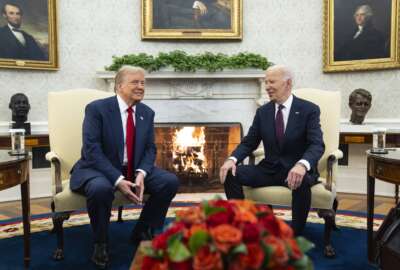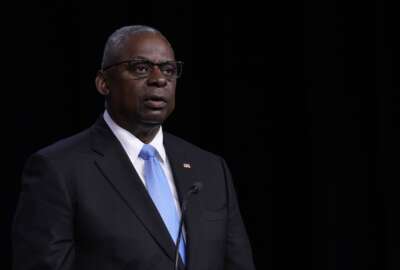Transition to Trump starts in earnest with agency landing teams
It's beginning to look a lot like a transition to the next Trump administration. The so-called landing teams should be dropping in on agencies this week.
It’s beginning to look a lot like a transition to the next Trump administration. In fact, the so-called landing teams should be dropping in on agencies starting this week. All this against a backdrop of budget uncertainty. David Berteau, veteran watcher and president and CEO of the Professional Services Council, joined The Federal Drive with Tom Temin for more details.
Interview transcript:
Tom Temin: And landing teams, they don’t come in on gliders or little helicopters, but they do arrive at the front door. Tell us more about what happens with landing teams and what they do.
David Berteau: Well, Tom, this is my eighth transition here in Washington. I go back to the Carter-to-Reagan transition as my first one where I was either in or out or an active bystander in the process. So this one is, of course, unique, but it also has some elements of history. They’ve come into play here. It’s been delayed. We’re now almost the middle of December and the election was November 5th, delayed for a number of reasons, not the least of which was the discussions between the Trump-Vance 2025 Transition Inc., which is their official transition organization, and the various parts of the federal government, including the General Services Administration. There’s appears to be agreement on a number of issues now. So we do expect the landing teams, the transition teams that are in the middle of the transition process to begin arriving at agencies as soon as today or later this week. That doesn’t mean they haven’t been working up to now. Those transition teams were set up. The organization was incorporated last summer and the teams have been busy working. Individuals have been busy plotting what to do. And one of the most interesting things to me is the degree to which these transition teams will be focusing on what the agencies are doing because, of course, the agencies are set up to brief them all and they would love to brag about what the initiatives they have underway. And equally importantly or perhaps more importantly, who will be doing it in which positions. And that’s really the key dynamic as both the what and the who.
Tom Temin: Right. And these people are coming in that will not actually work at the agencies, but they’re going to inform the people that will work at them.
David Berteau: Well, the regulations require them not to go represent someone else in front of the agency, but many of them will end up in an agency position. So the real ban is on lobbying that agency after you were part of the transition team. The standard GSA and statutory prohibition is two years. I believe that the Trump transition has its own internal ethics agreement, they call it. I haven’t read it, but it might be a shorter period of time or none at all for certain agencies. But I think one of the things that we’ll be watching for is who’s on these teams. Are they jockeying for position inside the agency or are they just, in fact, helping those who will take those positions get a good grounding of what’s underway? In the past, it’s been a mix and sometimes more focused on, ‘I want that job,’ and sometimes more focused on this is what needs to be done. We’re going to be watching this very closely this week and next week.
Tom Temin: And by the way, where is the coffee machine?
David Berteau: There is that. We’ve all had our own taking new jobs in new organizations. Takes a while to figure them out. Some agencies more than others. I would think the Pentagon is a little bit more of a labyrinth, although I have gotten lost in the Energy Department building as well.
Tom Temin: I remember my first day on a job well, it was 40 some years ago and my boss’s boss’s boss got in early along with me and he made the pot of coffee. So I remember.
David Berteau: That was quite a lesson.
Tom Temin: That’s right. He wasn’t too big of a big shot to make a pot of coffee and serve the new guy. And all of this, David, against the backdrop of the budget uncertainty, which kind of drives what anyone’s going to be able to do after the transition.
David Berteau: Tom you’d think we’d be familiar with this territory by now, right? A continuing resolution that extends to December. And now we’re facing the dynamic of we either have a government shutdown midnight Friday, a week from now, or we have an extension into what, some part of 2025? I haven’t seen the bill yet. We know that there’s work being done on it. We most likely will not have a government shutdown. Although, as you know at PSC, we pay very close attention to this. We have a very active shutdown resource center for our members and it’s up and running now. It’s prudent to prepare, even though the probability is quite low, the consequences would be high. And it’s not like we haven’t been here before, Tom. I mean, go back six years ago, 2018, we were headed towards an omnibus appropriation. And then the last few days, right before the Christmas break, that all crashed. And we ended up with a partial shutdown of nine cabinet departments and a bunch of other agencies that extended for more than 30 days. Sure. So don’t take anything for granted here. But it appears that the agreement is headed towards extending to next year. This has real problems, of course. But we can talk about those.
Tom Temin: We’re speaking with David Berteau, president and CEO of the Professional Services Council. And I remember when Trump signed his first budget as president and he vowed he would never sign a budget like that again, which didn’t quite hold up because budgets are what come out of Congress and you either sign them or you don’t. I wonder if he’ll remember that this time. It said, ‘Maybe I won’t sign it,’ which could lead to the shutdown if there’s a CR into the new presidency.
David Berteau: You’re absolutely right to point that out. And we may not know what is in the incoming administration’s mind, what’s in President-elect Trump’s mind. But we do know what history shows, right. And history shows that eight years ago, when President Trump won for the first time, we were moving along towards an FY 17 full year appropriations that got punted into the following year under the assumption that perhaps the incoming administration would have some impact on it. Ultimately, virtually the same bill passed, but not until April 26th. So there was very little impact on it and it delayed FY 18 budget submission by that same amount. You were seven months into the fiscal year before you had a full year appropriations. We at PSC would certainly hope that we could avoid that this time. The negative impact of that level of CR is enormous across all agencies.
Tom Temin: And the agencies don’t like it either.
David Berteau: No, they don’t. In fact, one of the difficulties is the program officers don’t know exactly how much money they’re going to get. They don’t know when they’re going to get it. They don’t know what’s going to be following in FY 26. Unsurprisingly, they will hold back on moving forward with new initiatives and new programs, some of which are prohibited under the CR anyway. But what this does is it delays the effects, Tom. For example, if you want to replenish the stockpiles that have been depleted with U.S. arms going to support the conflicts in Ukraine and in Israel, you would delay the replenishment by a substantial number of months or even a year or two or more by postponing the CR and by postponing the FY 26 budget. This is in no one’s interest.
Tom Temin: And finally, there is the other big less unknown, but still not signed, and that is the National Defense Authorization Act. And we knew the scope of both Houses bills. Now they’re together, but there’s no final bill yet.
David Berteau: Committees released the final bill late Saturday. It was a nice weekend gift to those of us who had to read its 1800 and something pages, plus nearly 700 pages of explanatory material. I didn’t finish it, by the way. I’ve still got more to go on this.
Tom Temin: Well, you only have to look at a couple of big series, 800, 900, 700.
David Berteau: As you note, we pay attention to the provisions, not so much the dollars that go to individual programs, but the provisions that affect acquisition and organization and the structures of the way the government does business. But there are two key signs, I think, in the overall NDAA. No. 1 is it is both consistent with the Fiscal Responsibility Act caps so we don’t have a change in the caps, and that bodes well for turning the CR into a full year appropriation. And it’s consistent with the administration’s request, which of course, was consistent with the caps. It’s not always that way, but it was this time. So that’s a big positive sign that there’s no effort yet to increase or change the overall top line. There is, of course, the supplemental. The administration requested $115 billion in supplemental funding. That’s not part of the NDAA. It may be part of the CR, but perhaps not all of it, perhaps modified. So that was one positive sign. The second positive sign is within that top line, the dollars allocated to the various categories tended to be pretty close again to the request. What this means is agencies and the contractors who support those programs can plan for those numbers. Now, keep in mind this is just the authorization. We still have to wait and see what the appropriators do. And they were a ways apart in the House and Senate versions of the bill.
Copyright © 2025 Federal News Network. All rights reserved. This website is not intended for users located within the European Economic Area.
Tom Temin is host of the Federal Drive and has been providing insight on federal technology and management issues for more than 30 years.
Follow @tteminWFED






